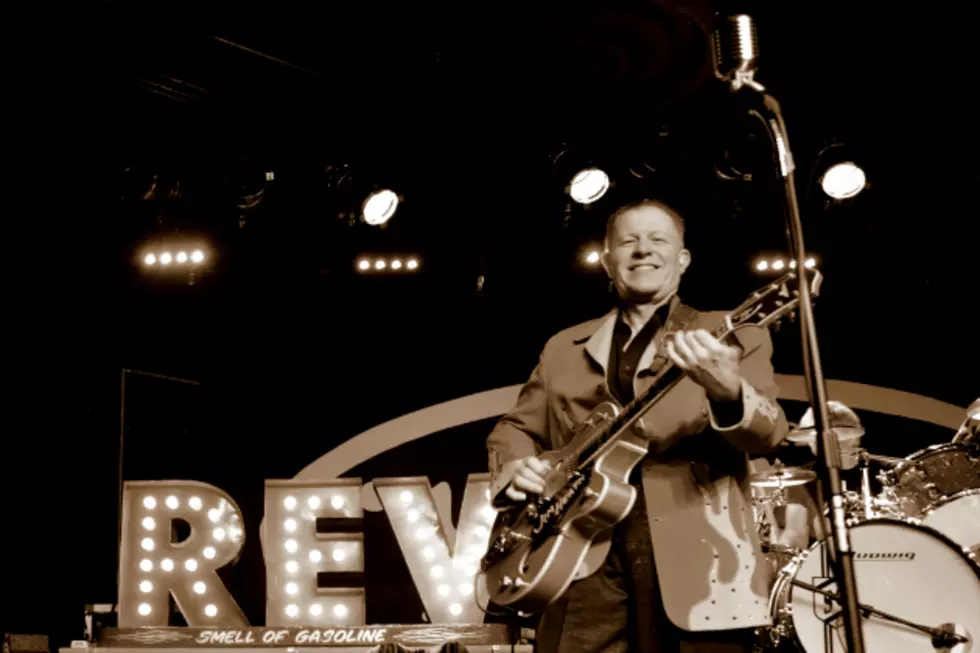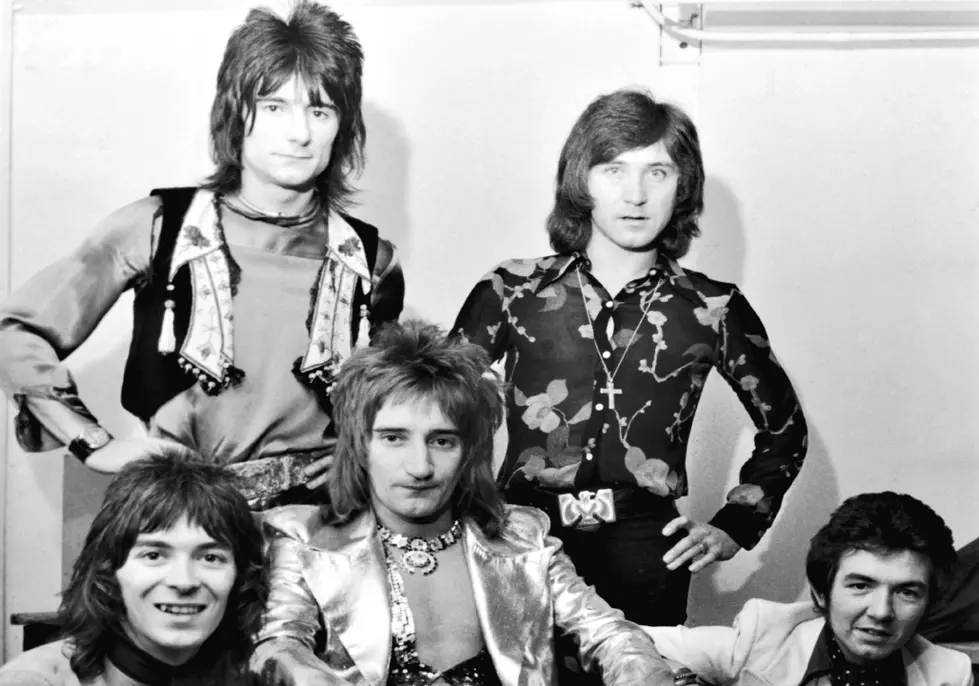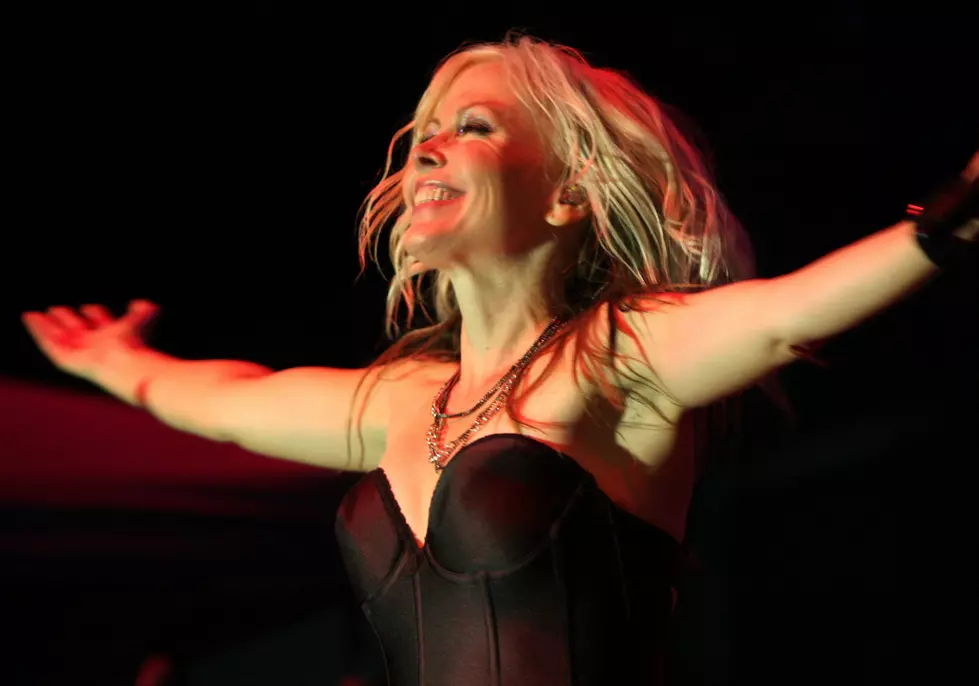
The Roots of Indie: The Reverend Horton Heat Talks Rockabilly
I kind of okey doked you with that title, but "The Reverend Horton Heat Talks Rockabilly, Punk, Psychobilly, Cowpunk, Rock and Roll, Conway Twitty, the Cramps, Blues and Anything Else You Want to Know" seemed a bit wordy. Talking to guitarist Jim Heath is like sitting down with your very own musical Google, just with a bit of a Texas drawl and a good sense of humor.
Heath was born at the tail end of the '50s and hit his teens just as the early '70s fifties revival was starting to boom. "The movie American Graffiti is a huge influence on me," the mild-mannered Heath tells me as we jaw backstage, and then he scurries into the nearest phone booth and quick changes into the Reverend Horton Heat. Later that night he joins Jimbo Wallace (bass) and Scott Churilla (drums) on stage, and the band rips through a set that's part good-time bar band and part rockabilly prayer meeting. Hallelujah.
The guitarist says that, "I'd been in rock bands. We had long hair. We thought we were going to be big. It never worked out." That all changed when he saw the connection between the music that he loved and the kind of band that would work out, but we're getting ahead of ourselves.
The band still gigs -- a lot -- and 2014's Rev, their first album for Victory Records, is every bit as good as any other record in their catalog. Heath is also partners in two music festivals: Dallas's Elm Street Music and Tattoo Festival and Horton's Hayride down in Long Beach, California. That seems as good of a place as any to kick off this interview, so let's stab it and steer.
Why don't you kick us off with a little info on the Hayride?
We have bands play through the day and a very limited car contest and car show. We want it limited, so we're trying to get the really good cars. We have vendors, and it's in downtown Long Beach, so there are plenty of places to go besides just the festival.
The format when we play is to have guests sit in with us. The old Grand Ole Opry, Louisiana Hay Ride -- they'd have their band and they'd get up there and they'd play a few songs, and then, "Okay here comes Kitty Wells, everybody."
Let's back up and talk a little bit about where rockabilly where came from.
The music that eventually became known as rockabilly came from the fusion of black rhythm and blues and white country and western, and a little gospel thrown in as well. Rockabilly was made available to the public when white DJs started promoting black rhythm and blues music alongside their country thing. It just started melting together in certain areas like New Orleans and Memphis and parts of Texas.
So more of a radio programming decision than a musical style at first.
A programming decision yes, but it was to meet the demand of the kids. The kids wanted wild music. When they first heard Elvis Presley he was singing Arthur Crudup's songs, an old black rhythm and blues singer. Back then nobody white sang that way, so a lot of people who showed up to see Elvis were shocked that he was a young white kid.
In that respect rockabilly is a really important cultural thing, because it's the melting of the races. It's the melting of what so many people even today consider to be people that are at odds with each other.
Now the term rockabilly itself, it's a little bit of a different animal. They didn't really call it rockabilly in the ‘50s. They'd just call it rock and roll, hillbilly bop, that kind of thing. Calling it rockabilly really didn't come in until the late ‘70s, early ‘80s.
So the term rockabilly gets popular around the time of the Cramps, early cowpunk, those kinds of scenes?
Yeah, I really think more the Stray Cats, the Blasters, Robert Gordon, and then some of the bands in England -- Restless and that kind of thing.
England took to rockabilly a lot earlier than we did, didn’t they? The Brits seemed more respectful of our ‘50s rock and roll in the ‘70s than we were.
Right, by that time we had kind of ... it was just a stupid, funny, inconsequential thing. It was Happy Days. It was the Fonz and you know, those terrible movies that they did about how cheesy the ‘50s were. The English, they had the Teddy Boy rockers, they never gave up on the ‘50s. It stayed there.
You mentioned Elvis and Arthur Crudup. One of the acts I always go back to when I think of Elvis is Big Mama Thornton and “Hound Dog,” which was just a filthy song. Somehow, Elvis made it and it was squeaky clean and good for the teens.
Well, it's a ripping rock and roll song, man. When I think squeaky clean, I think more of Pat Boone.
Rockabilly was a bit like the original punk rock back then. Sonny Burgess and his band, they had all red guitars and red suits and red drums. Because of that, people thought they were of the devil.
They’re wearing red, they must be devil worshipers.
Times were a lot different. Putting all that in perspective, I think helps people understand the coolness of the whole thing.
We get to the ‘70s and you've got bands like the Ramones and the Cramps and the Blasters that are really getting into that ‘50s and early ‘60s vibe. Were those bands influences on you?
Oh yeah, but that was later. I was influenced by the ‘50s a lot before that, too.
Without getting into the whole history, I had cousins that played music. I knew about Johnny Cash and Carl Perkins. Of course, Elvis, you couldn't get away from that. I really realized how cool it was with the movie American Graffiti.
Then later on, when those bands started to come in, really they were kind of like riding the punk rock wave.
That’s an interesting point. What connects punk and rockabilly?
Before 1977 it was a lot of southern rock. You had Lynyrd Skynyrd and the Allman Brothers, and then you had art rock, which was Emerson Lake and Palmer, Styx and all that stuff. Then you had your big rock bands like the Doobie Brothers, Grand Funk Railroad, or whatever. Then the punk rock thing hit and it really blew the whole idea of what could be and what music was.
My perception of it was instead of looking at the attitude and the dress and the culture of punk, I break it down into more of musically technical things. From the ‘50s, you had Jerry Lee Lewis and Little Richard pounding straight eights on the piano and Chuck Berry going straight eights on the guitar. After it died out, somewhere in the era where the Beatles went psychedelic, you didn't really have much rock and roll. You had this kind of rock, or blues rock, or whatever.
When punk rock came in, those Ramones songs are straight eights. Rhythmically, breaking it down. Punk rock was a way for rock and roll to come back.
Can you talk a little bit about psychobilly?
I would consider the Cramps to be maybe the first American psychobilly band. A lot of people think Reverend Horton Heat were the first because we had this song , "Psychobilly Freakout,” so I have to teach them about [the history].
If you take the Cramps a little out of the picture, then for me psychobilly is a European thing, basically, with bands like the Meteors, Iguana Bats and Demented Are Go. It was a big thing and it's still going in Europe. It was completely off the radar for America.
A lot of the psychobilly sound in Europe is upright bass. The Cramps never had upright bass. They would do some slow crazy, psycho type slow songs, or I guess better described as moderate tempo rock and roll beats but with an edgy thing.
With you and Flat Duo Jets and the whole swing revival in the early '90s, it looked like we had a real phenomenon going on.
Well, the swing thing got too big too quick, so a lot of people jumped on the band wagon without realizing that people were swing dancing because there were rockabilly bands coming through playing that music.
We would play a gig one night where they would be moshing and the next night we would be playing a gig where they were swing dancing. We tried to be adaptable, and we actually were pretty good at it and we still are. We go play country bars every now and then. Depending on the club it can be a real drag, but some of them are real fun and just historical and beautiful places.
Do you feel like you were pigeonholed because of “Psychobilly Freak Out”?
Well, yeah, I don't really feel like we are a true psychobilly band, because for one thing we do things that psychobilly bands don't do. We'll get country. We'll get bluesy, a little jazzy. Some of those bands will do a little bit of that, but not quite to the extent that we do.
I love psychobilly. I love those bands like the Meteors and stuff. Whenever we get asked to play those festivals over there I love going, and we're part of the psychobilly scene in Europe and worldwide. I appreciate us being in there, and I love going and doing it, but I don't really try to use that as, you know ....
Do you remember that flash point, that moment when you felt like this is my music?
Well, I have several different points that I had that.
When I was a kid, the first song I tried to learn to play was “Folsom Prison Blues.” I thought I was playing like Johnny Cash. I had no idea I was that trying to mimic Luther Perkins, the guitar player.
There was one gig, especially. I was hanging around a lot of blues clubs, and hanging around rockabilly record collector guys, and the Cramps came through. That was ‘79, I think.
Punk rock in Dallas -- in ‘79 it was still real fresh. So we went to see the Cramps, and it was, oddly enough, at a heavy metal type club. It was shocking how crazy Lux Interior was, like watching some Nazi drag show, or something. I didn't know what to think of that man. It was crazy, man.
Then they were playing Jack Scott, “The Way I Walk.” Man, they're like a ‘50s band, you know?
For me, being basically more of a blues guy that dabbled in the ‘50s thing in between my rock and roll bands and what have you, I thought, “This is it. I can make this thing work.” I had the same idea right around the same time that the alternative scene was accepting Robert Gordon, the Blasters and the Stray Cats.
The Stray Cats got big and everybody had bands. There was the great rockabilly scare of ‘83.
You had Rank and File and cowpunk breaking in Austin right around the same time that you're talking about. Do you see any overlap between cowpunk and psychobilly?
Oh yeah, sure. A lot of those bands, like Jason and the Scorchers and Rank and File, are kind of unsung heroes of the whole bit.
I think that that was definitely a component. I think a lot of people thought that the cowpunk thing would actually get a lot bigger than it did. Yeah, that was right around the same era. You know, things come and go so fast, man.
They really do.
That era was important especially for rockabilly because it was back. The Stray Cats brought it back. You had The Cramps. You had The Blasters. The Blasters are still around. Reverend Horton Heat is still around. The off shoot bands of all those things are still going really well, with the Southern Culture on the Skids and, you know, different versions. Robert Gordon still plays gigs. It was important to bring back the real rock and roll that started the whole thing.
More From Diffuser.fm









